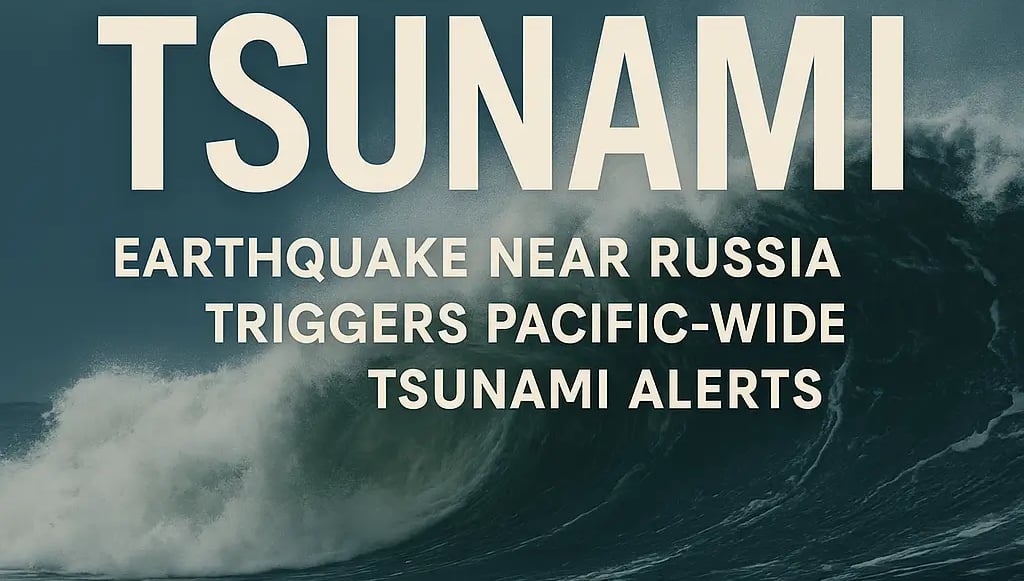July 2025 Tsunami Update: Earthquake Near Russia Triggers Pacific-Wide Tsunami Alerts
July 2025 Tsunami A powerful 8.8-magnitude earthquake near Russia’s Kamchatka Peninsula triggered tsunami warnings across the Pacific, including Japan, Hawaii, and the U.S. West Coast. Discover key impacts, wave heights, affected regions, and emergency responses.


🌊 Overview: July 2025 Tsunami After Kamchatka Earthquake
On July 29–30, 2025, a massive 8.8 magnitude earthquake struck off Russia’s Kamchatka Peninsula—the strongest in the region since 1952. The quake occurred at a shallow depth of around 11 km and was followed by powerful aftershocks around magnitude 7.5, prompting immediate tsunami warnings across the Pacific (The Week, People.com).
🌍 Affected Regions & Impacts
Russia — Kuril Islands & Kamchatka
Coastal towns like Severo-Kurilsk were inundated by waves estimated at up to 4 meters (13 ft), causing flooding of ports and minor injuries. Some marine wildlife was seen fleeing on camera (Reuters).
Japan — Hokkaido and Pacific Coast
Tsunami heights near 40 cm (1.3 ft) were recorded in Hokkaido and across other coastal areas.
Close to 900,000 residents were issued evacuation advisories, though no major damage or casualties were reported (The Week).
Hawaii & U.S. West Coast
Hawaii experienced tsunami surges:
Kahului: ~5.7 ft (1.7 m)
Hilo, Haleiwa, Hanalei: between 3.9–4.9 ft
Evacuation orders were lifted the same day but advisories remained due to hazardous currents (News.com.au, nypost.com, livemint.com).
Smaller wave amplitudes reached California, Oregon, Washington, and British Columbia. Coastal advisories and watches were issued and later downgraded (Al Jazeera).
Other Pacific Regions
New Zealand, Guam, the Galápagos, French Polynesia, Ecuador and Micronesia were placed on alert and saw minor surges. In most cases, the danger passed without major impact (Al Jazeera, hindustantimes.com, Indiatimes).
🚨 Emergency Response & Safety Measures
Authorities issued evacuation orders and tsunami advisories across multiple countries.
The Tokyo and Hawai‘i Emergency Management Centers coordinated mass evacuations swiftly, while transport hubs and nuclear facilities enacted protocols without reported injuries (People.com).
Media captured tense moments, including a live BBC interview abruptly cut short due to a tsunami siren on Oahu (The Sun).
Cruise ships such as Royal Caribbean's Quantum of the Seas navigated through tense alerts—passengers described scenes of panic mitigated by safety assurances (People.com).
🌐 Scientific Context & Long-Term Outlook
The earthquake occurred along a megathrust fault in the Pacific "Ring of Fire", a zone prone to major subduction earthquakes and tsunamis (Reuters).
Experts caution that tsunamis often deliver multiple waves over several hours—the first may not be the most powerful. This explains why warnings remained in some regions even after initial surges passed (ABP Live, The Guardian, Indiatimes, nypost.com).
🔍 Summary Table
Region Maximum Wave Height Evacuations / Advisories Recorded Impact Russia (Kamchatka, Kurils) ~4 m Full coastal evacuation Port flooding, minor injuries Japan (Hokkaido) ~0.4 m ~900,000 under advisory Minimal impact, no injuries Hawaii ~1.7 m (surges) Initial evacuations, later advisories No major damage US West Coast Small surges Warnings/advisories coast-wide Minor coastal currents Other Pacific Islands <1 m Alerts issued, generally lifted No significant effects
✅ Key Takeaways
Event Scale: One of the strongest earthquakes in decades, spanning multiple nations’ Pacific coasts.
Rapid Action: Coordination across national and international agencies successfully minimized harm.
Long-Duration Risk: Tsunami threats lingered due to repeated aftershocks and delayed wave arrivals.
Environmental Impact: Wildlife panicked; ecosystems were visibly affected in impacted areas.
Public Communication: Swift advisories and media updates helped populations respond effectively.
If you'd like focus on specific aspects—like geological causes, local emergency preparedness in India or other affected nations—just let me know!
